back to
homepage & photographs
Page 1.
I 2.
I
3. I
4. I
5. I
6. I
Tasks
4. What happened to the rest of the K Class Submarines?
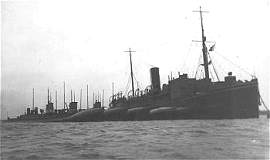
HMS Pandora resupplying some K Class submarines (K22, K15)
But not even the disaster of the K13 shook the Admiralty's confidence in their steam submarines and shortly after the first six boats were formed into a new 12th Flotilla and given the task of hunting U-boats. It was as farcical idea as hunting fleas with an elephant. The unhandy K-boats took a full four minutes to dive and, once submerged, they were often slower than their German targets. To pit one of these steam monsters against an agile well-handled U-boat was the height of absurdity, yet so skilled were their captains that even the ridiculous almost worked.
First, however, there was the usual K-boat comedy of errors, K-7, running submerged in the Channel, was mistaken for a U-boat by two destroyers and, minutes later, depth charges were exploding all around her. Gilbert Kellet, her skipper, managed to wriggle clear and, surfacing, plaintively signalled that 'he was on their side'.
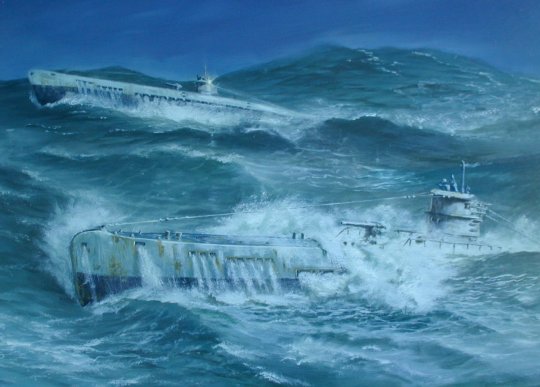
Later that day Kellet had the luck to spot a U-boat on the surface but, influenced by the K-boat's malevolent hoodoo jinx, his first torpedo missed. Undismayed he followed up with a salvo of four. One of them struck the U-boat fair and square on the beam. But with typical K-boat luck, it failed to explode. Kellet brought K-7 to the surface intending to use his superior speed but the German skipper was an equally cunning adversary. He took one look at the smoke belching giant erupting from the sea like some primaeval marine monster and hurriedly dived for cover. It was now Kellet's turn to be exposed on the surface and deciding not to play any more, he steamed K-7 away from the area as fast as he could. It was during this U-boat hunting phase that K-1 inconsiderately ran herself aground near Bow Rock. She was not seriously damaged but in accordance with the Navy's regulations her skipper, Charles Benning came up before a court martial charged with hazarding his ship. With a perfectly straight face Benning explained that rats had eaten the chart of the anchorage. And with equally straight faces the Board accepted his reason and dismissed the charge. It was a reason that only a K-boat captain could have got away with.
Five months later, on November 16, 1917, the 12th Flotilla was sent out with the Grand Fleet for an offensive sweep towards Denmark. The lumbering K-boats snaked in an untidy line behind the cruiser Blonde but despite the difficulties of station keeping, all went well. When Blonde swung onto a new course at 10 pm the line of submarines slowed and bunched. Helms were quickly ported, but, for K-4 not quickly enough. There was a sickening crunch of steel on steel, and her bows rammed hard into K-1's stern.
Prompt work in closing watertight doors prevented immediate disaster and while Blonde took the crippled boat in tow the crew were taken on board the cruiser. But the weather was deteriorating fast and despite an heroic attempt to salvage the wounded monster Blonde's captain was forced to sink her with his own guns.
Back at Scapa Flow the morale of the 12th Flotilla fell to a new low when it was learned that all K-boats were to be fitted with redesigned bulbous bows. And the inference that they were not seaworthy in their present condition did nothing to allay the fears which the men felt each time the lumbering giants left harbour.

The men of K-2 nearly rose in mutiny over an imagined grievance concerning ship's prayers and when the crew of a J-class boat were ordered to transfer to the new K-22 - in fact the old K-13 of Gareloch notoriety which had been salved, refitted and re-numbered - many of them reported sick with a mysterious illness which enabled the, fortuitously, to evade the unwelcome draft.
It seemed that nothing could satisfy the evil hoodoo brooding like the shadow of death over the steam submarines and February 1918 saw a spectacular disaster involving no fewer than nine of the smoke-belching monsters.
Now split into two flotillas - the 12th and, ominously, the 13th - they were slated for Operation EC in which the Rosyth Force was to rendezvous with the Grand Fleet in the North Sea. The light battle cruiser Courageous led the fleet out of the Firth of Forth followed by Leir's 13th Flotilla, four battlecruisers, Little's 12th Flotilla and then the rest of the fleet.
It was dark when they reached the mouth of the estuary and then to add
to the difficulties of night navigation a light mist hung over the water.
Leir's boats were travelling at 19 knots, running nose to tail, and
following the shaded blue stern light of the submarine next ahead.
Suddenly a group of minesweepers, ignorant of the fleet operation in
progress, swept across the line of approach.
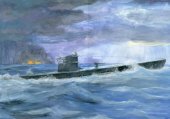
K-11 cut speed and turned to port, K-17 followed suit but K-14. third submarine in line, continued straight ahead although, she, too, reduced speed. Realising that he was getting too close to the boats ahead, K-14's skipper, Harbottle, ordered full right rudder but, at the vital moment, the K-boat hoodoo jinx jammed the helm and she swung away in a wide circle leaving K-12, immediately astern, to pass clear, blissfully unaware of her flotilla mate's antics.
By now the immaculate line-ahead formation was in utter shambles and K-22, bringing up the rear, suddenly found another submarine lying broadside across her path. It was too late to avoid a collision and still running at 19 knots K-22's bows sliced deep into K-14's port side abaft the forward torpedo compartment. Prompt action in shutting the watertight doors saved the two submarines from immediate disaster but they were still lying together and rolling gently in the swell as the four battlecruisers swept on to the scene. Three passed safely, their wash making the submarines rock violently, but the last, Inflexible struck K-22 a glancing blow that stripped the plating from her bows.
When Leir learned of the collisions astern he reversed course and led his cruiser-flagship and the remaining submarines back toward the scene to assist. And realising the dangers of his action he switched on Ithuriel's full navigation lights to warn other ships of their approach. The battlecruiser Australia narrowly missed the group in the mist and shortly afterwards there was a mad scramble when they met a destroyer flotilla steaming at high speed.
Captain Little. leading the 12th Flotilla, carefully avoided the
collision area but was unaware of Leir steaming toward him with the
remnants of the unlucky 13th. Suddenly both groups loomed out of the mists
and met head-on like armoured knights clashing on the jousting field.
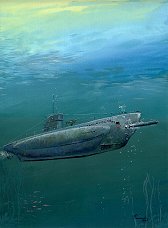 A
later Class Sub.
A
later Class Sub.
Fearless, the cruiser leading the 12th Flotilla, smashed into K-17 just
forward of the conning tower and as the submarine twisted clear and reeled
away into the darkness she was already sinking fast. K-3 nearly rammed K-4
and a disastrous collision was only avoided by brilliant ship handling.
And K-6 narrowly missed a head-on shunt with K-12 of Leir's flotilla. With
all form of control lost the flotillas dissolved into utter confusion with
both groups of submarines hopelessly intermixed and milling around in all
directions as their frantic skippers jinked and twisted to avoid each
other.
K-6 sank her bows deep into the side of K-4 almost slicing her completely in half and locked together in a fatal embrace both submarines began sinking. Commander Layton managed to draw free by running K-6 full astern but K-4 stood no chance of survival and she plunged to the bottom like a stone. She sank so quickly, in fact, that when K-7 arrived a few seconds after the collision she passed right over the spot without even scraping her keel. Putting her engines into reverse K-7 moved slowly astern to search for survivors.
But the men struggling in the water did not belong to the unfortunate K-4 - they were the crew of K-17 still swimming in the darkness after the previous disaster!
The 5th Battle Squadron, although warned of the collisions, was unaware that both flotillas were milling around directly ahead and while K-7 was still trying to rescue survivors the great dreadnoughts swept onto the scene at 21 knots. What followed was probably the most ghastly tragedy of that terrible night.
The escorting destroyers ploughed straight through the helpless men in the water, cutting them to pieces with their propellers, and when they had run clear only nine men remained alive - and one of these would die later. Not a man escaped from K-4.
But dangers, disasters, and the injustices of the Court of Inquiry that followed, could not quench the spirits of the submarine crews. And when Commander Layton handed K-6 over to Cdr. Crowther - who'd been on board as a guest on that terrible night off May Island - he observed drily that the disasters were good experience and 'a bloody good introduction to K-boats'.
The Battle of May Island, as the multi-disaster came to be known, should have marked the end of the K-boats miserable saga. Unfortunately it didn't!
K-16 carrying out a carbon copy of K-12's diving trials in Gareloch, ended on the bottom in the same way although, fortunately, her skipper Charles de Burgh managed to blow the ballast tanks and bring her back to the surface without further incident. But for the men who made up her crew it was a terrifying experience.

And in May 1918 the newly completed K-15 lived up to the steam submarines' unenviable reputation when a beam sea entered her funnel intakes, swamped the fans, and extinguished the boilers. Although running on the surface her commander responded with an unexpected order - 'shut off for diving!' It was a lucky decision. The water entering the boiler room destroyed the submarine's positive buoyancy and the stern sank slowly to the bottom leaving her bulbous bows exposed above the surface. They had closed the watertight doors in the nick of time thanks to their quick-thinking commander.
Jammed valves prevented the ballast tanks from being blown and it was eight hours before the pumps could be persuaded to bring her back to the surface. It was yet another example of the K-boat hoodoo jinx.
The ports in the funnel superstructure had been designed to open both ways - an unsound detail in a vulnerable vessel like a submarine - and all the boats were modified to correct this fault. All, that is, except K-15. Someone had forgotten her. And but for the instant reaction of her captain, Vaughan Jones, it was an oversight that could have cost the lives of her entire crew.
K-3, commanded by Herbert Shove, an eccentric who usually carried two white rats in the pockets of his uniform, went out of control in the Pentland Firth and struck bottom at 266 feet. In what were regarded as shallow waters K-3 with an unerring eye for disaster,had picked the one spot where there was a large hole in the seabed. Fortunately it was the hoodoo's day off and despite the tremendous pressure to which her hull was subjected Shove got her back to the surface none the worse for her escapade.
Even when the war was over the K-boats continued to add to the Navy's losses. The brand new K-26 scalded two stokers to death when faulty valves caused a blow-back of super-heated steam during trials and K-2 and K-12 collided on leaving Portland Harbour.
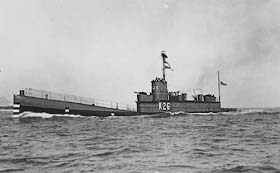
No one was hurt on this occasion but the Admiralty were none too pleased with the repair bill. And the remaining K-boats continued to suffer their usual plague of troubles when they joined the Atlantic Fleet for exercises in January 1921.
K-9's warning light failed to come on during a preliminary trimming dive and her horrified officers found a coil of rope carelessly stuffed under one of the ventilators preventing it from closing. She was still giving trouble when she dived later in the exercises but, more alarmingly, K-22 was having even greater trouble surfacing. The fault could not be traced but, taking no chances, Commander Poland blew all tanks and threw her engines full astern even though his unexpected appearance on the surface meant disqualification by the war game umpires. But, as Poland knew, you could not play games with a K-boat. It was war, deadly war.
Having been thwarted twice the hoodoo took a savage revenge on K-5 - a submarine that had already buried her bows in the bottom of the Firth of Forth without apparent cause and also collided with an old destroyer at Milford Haven - with macabre efficiency. She dived with the other boats to carry out a dummy attack on a cruiser squadron and she never came up again. An oil slick and splintered wood on the surface showed she had broken up underwater. And entombed in their unmarked grave under the Atlantic her six officers and 51 men perished like their comrades in the K-boats before them.
Even changing the class letter did not defeat the hoodoo jinx. Toward the
end of the war three K-boat hulls were used to build the
M- class submarines. M-1 carried a single monster 12-inch gun; M-2 was
fitted with a small seaplane which nested in a bulbous hangar on the
foredeck; and M-3 was designed as a minelayer. And in a final attempt to
escape the evil reputation of the K-boats they were equipped with 1400 HP
diesel engines in place of the hated steam turbines.

But it did them little good. Call them what you will but they were
still basically K-boats and the hoodoo was not easily fooled. On
November 12, 1925 M-1 was struck by the Swedish ship Vidar 15 miles off
Start Point and went down with her entire crew of 69 officers and men.
Then seven years later, in 1932, M-2 vanished in Portland's West Bay. A
passing collier reported seeing 'a large submarine diving stern first' - a
fact she did not seem to consider unusual. And when Navy divers located
the submarine on the bottom eight days later the found the hangar door,
the conning-tower hatch, and the pressure hull, all wide open. Although
various theories were advanced no convincing explanation of the sinking
was ever produced.As the former coxswain of K-13 commented: 'She was a
K-boat originally. What more do you need to know than that?' And Coxswain
Oscar Moth knew what he was talking about. He had survived the Gareloch
disaster in K-13, had volunteered to serve in her again when she was
salved and re-numbered K-22 and had emerged
unscathed from the Battle of
May Island.
 M1
M1
Back in 1913 when the idea of steam-powered submarines was first mooted Admiral Jacky Fisher had retorted scathingly: 'The most fatal error imaginable would be to put steam engines in submarines.'
He was so right . . .
Coloured pictures are from http://www.subart.net
From: http://www.submariners.co.uk/Dits/Articles/steamsubs.htm
This site other site is also very good :
http://brisray.com/misc/mkclass1.htm
"...the body of Goodhart was found trapped in the superstructure.
One of the missing bodies turned up in the Clyde two months later. None
of the civilians or officers ever sailed in a submarine again. Petty
Officer Moth went bald within weeks of the accident..."
Top  www.interactive-learning.com.au
www.interactive-learning.com.au